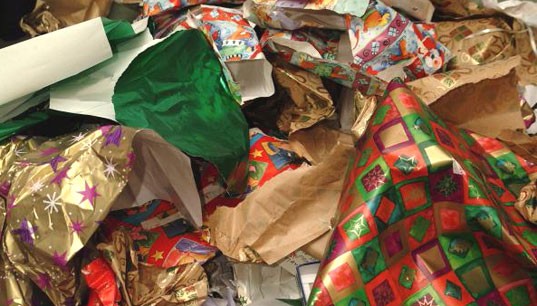The holiday season often brings joy, celebration, and the exchange of beautifully wrapped gifts. While the wrapping paper adds to the festive atmosphere, it also generates a considerable amount of waste. Instead of tossing all that wrapping paper in the trash, have you considered composting it? Composting wrapping paper can be an eco-friendly way to reduce your environmental impact during the holidays. In this article, we’ll explore the benefits of composting wrapping paper, how to do it correctly, and the types of wrapping paper that are compostable.
Contents
The Benefits of Composting Wrapping Paper
- Reduces Landfill Waste: By composting wrapping paper, you divert it from landfills, where it contributes to the growing problem of waste disposal. In landfills, paper products can take years to decompose, releasing methane, a potent greenhouse gas, in the process. Composting is a more sustainable option that helps reduce this environmental burden.
- Creates Nutrient-Rich Compost: Wrapping paper is typically made from paper or cardboard, both of which are carbon-rich materials. When added to your compost pile, they act as “browns” and balance the carbon-to-nitrogen ratio. Composted wrapping paper breaks down over time, enriching your compost with essential nutrients that can improve your garden’s soil quality.
- Saves Resources: Recycling paper consumes energy and water, while producing new paper products requires cutting down trees. Composting wrapping paper is a more resource-efficient choice that supports a circular economy.
- Fosters Sustainability: Composting your holiday wrapping paper aligns with the principles of sustainability and eco-conscious living. It’s a small yet meaningful step toward reducing your environmental footprint.
Types of Wrapping Paper that Can Be Composted
Not all wrapping paper is suitable for composting, as some may contain non-compostable elements such as plastics, foil, or non-biodegradable inks. To ensure you’re composting the right kind of wrapping paper, consider the following types:
- Plain Paper or Cardboard: Plain, uncoated paper or cardboard wrapping paper is the most compostable option. Look for designs that don’t contain glossy finishes, metallic foils, or synthetic inks.
- Vegetable-Based Inks: Wrapping paper printed with vegetable-based inks is a more sustainable choice, as these inks are less harmful to the environment and can be composted.
- Non-Metallic or Natural Embellishments: Some wrapping paper may feature non-metallic, natural embellishments such as pressed flowers, leaves, or seeds. These embellishments can be composted along with the paper.
How to Compost Wrapping Paper
Composting wrapping paper is a straightforward process, but it requires some care to ensure that the paper breaks down efficiently. Follow these steps for successful wrapping paper composting:
- Remove Non-Compostable Elements: Before adding wrapping paper to your compost pile, remove any non-compostable elements, such as tape, ribbons, plastic bows, or metallic decorations. These should be separated and disposed of properly.
- Shred or Tear into Smaller Pieces: To expedite the decomposition process, shred or tear the wrapping paper into smaller pieces. Smaller pieces have more surface area, allowing microorganisms to break them down faster.
- Layer with Green Materials: Wrapping paper is a carbon-rich, or “brown,” material. In your compost pile, it should be balanced with nitrogen-rich, or “green,” materials like kitchen scraps, yard waste, or fresh plant materials.
- Keep It Moist: Maintaining the right moisture level in your compost pile is crucial. Wrapping paper is often dry, so make sure to keep your pile adequately moist, similar to a wrung-out sponge.
- Aerate the Pile: Regularly turn or aerate your compost pile to promote even decomposition and prevent compaction. Proper aeration ensures that oxygen reaches the microorganisms responsible for breaking down the materials.
- Be Patient: Wrapping paper may take some time to break down completely, especially if it’s in larger pieces. Over time, it will transform into rich, crumbly compost that you can use in your garden.
Types of Wrapping Paper to Avoid Composting
While many types of wrapping paper can be composted, some are best avoided due to their non-compostable elements:
- Glossy or Metallic Wrapping Paper: Wrapping paper with glossy finishes or metallic foils should not be composted. These elements do not break down and can contaminate your compost.
- Plastic-Coated Wrapping Paper: Wrapping paper that feels plastic-coated or waterproof is not suitable for composting. The plastic coating prevents it from breaking down effectively.
- Adhesive Tape and Plastic Bows: Remove adhesive tape, plastic bows, and other non-compostable elements before adding the wrapping paper to your compost pile.
Wrapping Paper Alternatives for a Sustainable Holiday
To further reduce your environmental impact during the holidays, consider using sustainable wrapping paper alternatives:
- Fabric Wraps: Reusable fabric wraps, such as scarves or tea towels, can be a charming and eco-friendly way to wrap gifts. They can be used year after year.
- Recyclable Wrapping Paper: Look for wrapping paper that is made from recycled materials and is also recyclable. After unwrapping gifts, be sure to recycle the paper properly.
- Brown Kraft Paper: Plain brown kraft paper is an eco-friendly and recyclable option. You can decorate it with eco-friendly inks, stamps, or natural embellishments.
- Gift Bags: Reusable cloth or paper gift bags are a sustainable choice. Simply fold and store them for the next holiday season.
In conclusion, composting wrapping paper is a sustainable and eco-friendly approach to managing holiday waste. By choosing the right type of wrapping paper and following the proper composting process, you can reduce landfill waste, create nutrient-rich compost, and promote a more environmentally conscious holiday season. It’s a small but impactful step towards a greener future and a more sustainable way to celebrate and give during the holidays.










